Exploring Ho Chi Minh City, once known as Saigon, is an exciting adventure. The city’s weather changes with the seasons, from hot in April and May to rainy from May to November. The cooler months of December and January are perfect for exploring.
Getting to Ho Chi Minh City is easy, with Tan Son Nhat International Airport at the center. You can also take a bus from Phnom Penh or a train. Taxis and Grab, a popular ride-hailing app, make getting around simple.
The city is a hub of economic activity, contributing a lot to Vietnam’s GDP. It’s a place where technology, finance, and manufacturing meet. District 1 is the heart of finance, culture, and administration, with modern and traditional sights.
Ben Thanh Market is a must-visit for its flavors. Thao Dien is great for global cuisine. Ho Chi Minh City is alive with over 8 million people, rich history, and vibrant culture.
Key Takeaways
- Tan Son Nhat International Airport is the primary gateway, offering easy access to and from the city.
- The city’s French colonial architecture, alongside modern skyscrapers, presents a striking visual contrast.
- Ho Chi Minh City’s cuisine is a diverse tapestry, reflecting the city’s cultural melting pot.
- As a major economic center, the city plays a crucial role in Vietnam’s prosperity.
- Offering a tropical climate, the city’s weather ranges from warm and wet to cooler, drier seasons.
- Ho Chi Minh City’s bustling nightlife and thriving shopping districts are major attractions.
- Local and international transport options ensure visitors can easily navigate the city.
Exploring the Vibrant Streets of Ho Chi Minh City
Start your journey in Vietnam with Ho Chi Minh City’s lively streets. Every corner has its own story, enticing smells, and endless energy. It’s a place where local life is always in motion.
A Glimpse into the Local Way of Life
Walking through Ho Chi Minh City’s street markets is a sensory adventure. Ben Thanh Market is a small world of its own, filled with silk, street food, and more. It’s a true reflection of Vietnamese street culture, showing the daily lives of vendors and artists.
At dusk, the city comes alive. Families and friends meet on street corners, sharing stories and food. This casual dining under the stars brings the community together, offering a genuine taste of local life.
Ho Chi Minh City’s Iconic Modes of Transport
The city’s transport is as lively as its streets. You’ll see cyclos, motorbikes, and new public transit like buses and a soon-to-come metro. This network makes it easy for everyone to get around, whether for work or play.
Renting a motorbike is a thrilling way to see the city. It lets you explore its lanes and feel its energy up close. With plans to improve transport, like the metro, traveling will get even better.
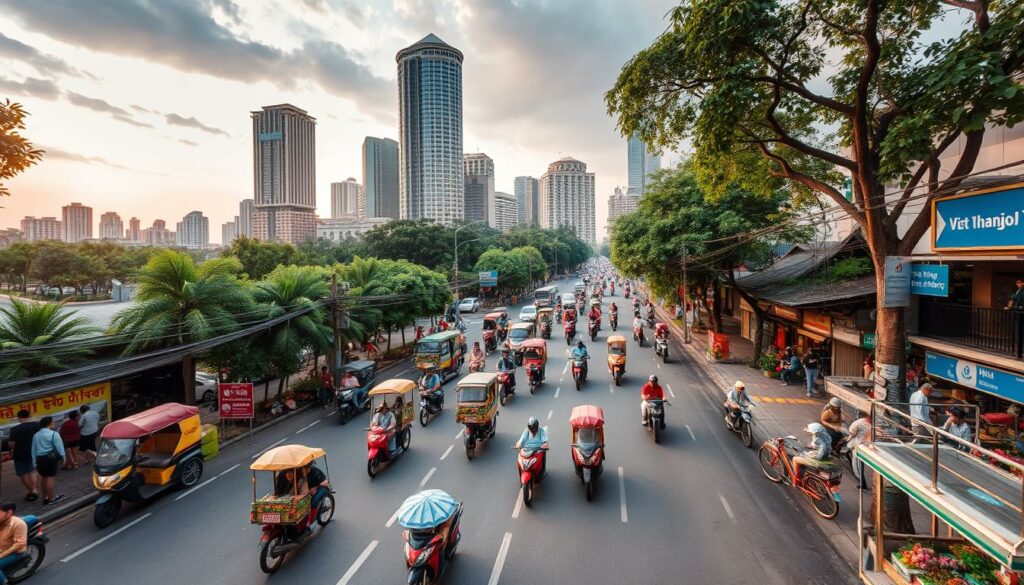
Ho Chi Minh City is a mix of tradition and modernity. Its streets and transport systems are full of life and culture. Here, the old and new blend, creating a vibrant city that welcomes all visitors.
Savor the Flavors: Ho Chi Minh City’s Diverse Cuisine
The Ho Chi Minh City food scene is a colorful mix of Vietnamese cuisine. The city’s food ranges from lively street markets to fancy restaurants. It’s a place where flavors tell stories of the city’s culture and history.
District 4, especially around 200 Xom Chieu Street Food Alleyway, is a top spot for local food. It’s bustling from dawn till dusk, giving visitors a real taste of local life. Here’s why it’s a must-visit for food enthusiasts:
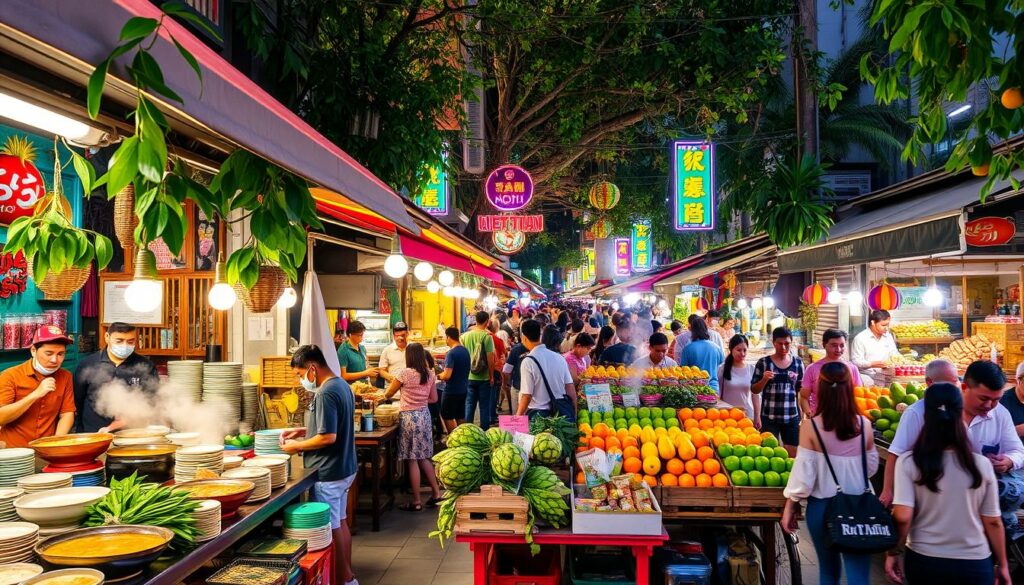
- The alleyway has many stalls, each serving unique regional dishes that show the heart of Vietnamese cuisine.
- With just 200,000 VND ($8 USD), you can try a variety of dishes that make up the rich local food scene.
- The best time to go is at 6 PM. The alley is full of life, offering food and a glimpse into local culture.
For a deeper dive into the Ho Chi Minh City food scene, consider a guided street food tour. These tours reveal hidden spots and local favorites, giving you a deeper understanding of the city’s food culture.
| Tour Option | Cost | Duration |
|---|---|---|
| Typical Ho Chi Minh Street Food Tour | $25 – $50 | 3 hours |
| Ho Chi Minh – My Tho | $148 (Discount 20%) | 4 Days |
Exploring Ho Chi Minh City’s alleys and markets is a feast for the senses. Whether you’re trying Pho or Banh Mi, each dish tells a story of Vietnamese culture. It’s a key part of the lively Ho Chi Minh City food scene.
Architectural Wonders: French Colonial Influence and Modernity
Ho Chi Minh City is a vibrant mix of cultures. It shows off the French colonial architecture’s brilliance. The Notre Dame Cathedral Saigon and the Saigon Central Post Office are key examples. They highlight the French impact on Vietnam’s history and beauty.
Notre Dame Cathedral: A Historical Beacon
The Notre-Dame Cathedral Basilica of Saigon is a spiritual and architectural gem. Built from 1870 to 1880, it has twin bell towers reaching 190 feet. Each bell weighs 600 kgs.
The cathedral’s red brick facade, brought from France, combines Gothic and Romanesque styles. It attracts tourists and architecture lovers.
The Awe-Inspiring Saigon Central Post Office
The Saigon Central Post Office is a French architectural marvel. Built from 1886 to 1891, it was designed by Gustave Eiffel. Its French and Gothic influences are seen in its arches and details.
Inside, the marble floors and grand interior take visitors back to a time of elegance. It was for sending letters.
A brief look at the broader impacts of French colonial architecture on Vietnam is captured in the following detailed table:
| Feature | Impact | Examples in Ho Chi Minh City |
|---|---|---|
| Façade and Aesthetics | Introduces European artistic styles to local architecture | Notre Dame Cathedral, Saigon Central Post Office |
| Material Usage | Red bricks, marble floors signifying durability and luxury | Red bricks in Notre Dame Cathedral Saigon |
| Architectural Style | Gothic and Romanesque styles promote Western architectural dialogue | Gothic arches in Saigon Central Post Office |
| Cultural Impact | A blend of local and French traditions, influencing local lifestyle and culture | Cultural tours and academic studies centered on landmarks |
These architectural wonders are not just old relics. They are key cultural and tourist spots in Ho Chi Minh City. They make visiting this city a deep journey through history and beauty.
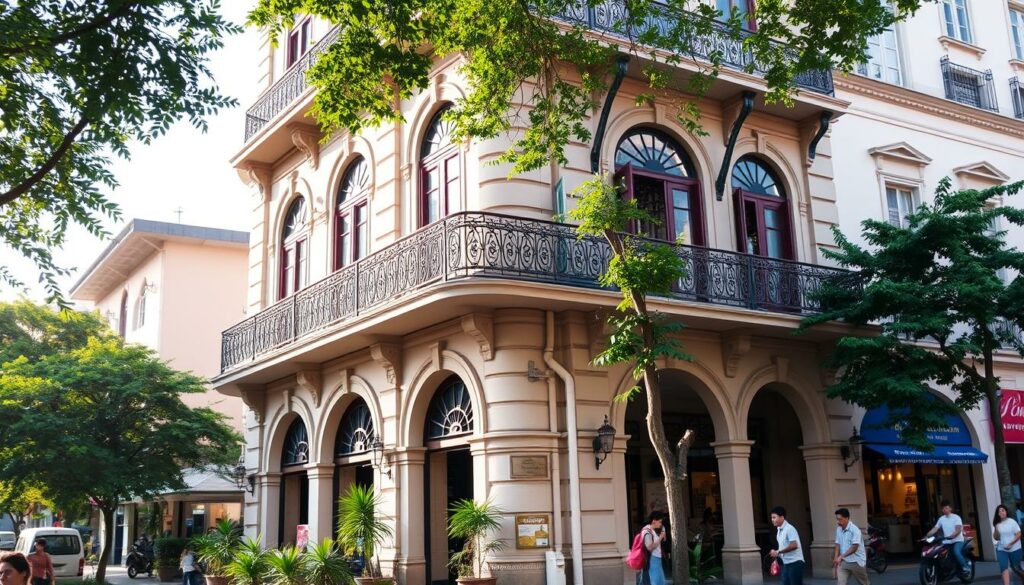
Ho Chi Minh City: A Haven for Shoppers and Culture Enthusiasts
Ho Chi Minh City is a perfect mix of old traditions and new ways of life. It’s great for those who love to shop and explore art. The city’s markets and cultural sites tell stories of old and new coming together.
Traditional Markets and Modern Shopping Centers
Shopping in Ho Chi Minh City is more than just buying things. District 1, the city’s heart, has Ben Thanh Market. It’s a place to find local crafts and experience the city’s lively vibe. With over 1,500 stalls, it’s a paradise for those who love to find deals.
Nguyen Hue Walking Street offers a modern shopping vibe. It has boutique shops and places to eat. This street is perfect for those who want to shop and relax in an open-air setting.
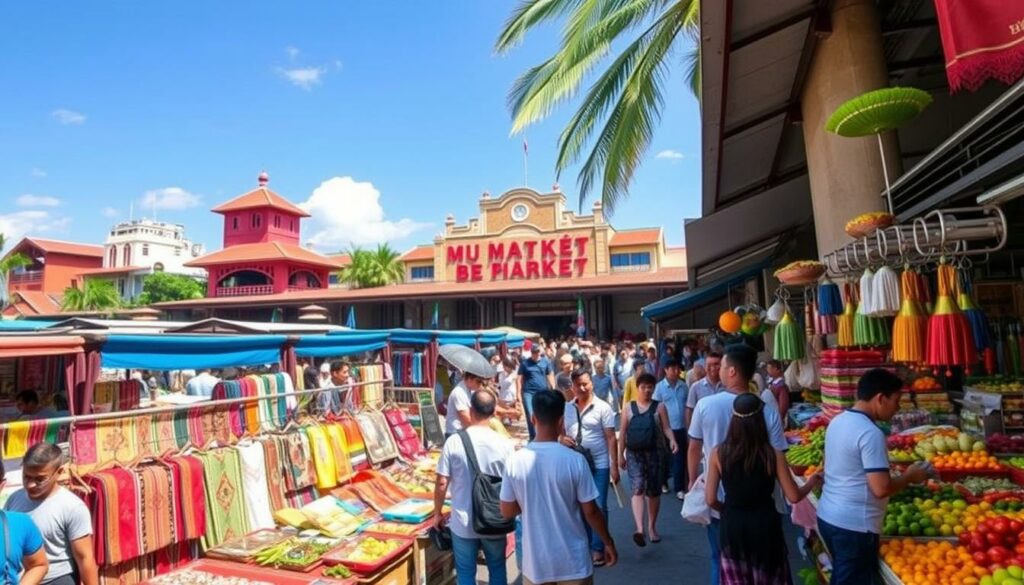
Art Galleries and Boutique Stores
The city loves art, as seen at the Ho Chi Minh City Museum of Fine Arts. It has a huge collection of art that shows Vietnam’s rich history. This museum is a top spot for art lovers, showing the past and present of Vietnam.
Modern art spaces like 22 Lý Tự Trọng and 42 Nguyễn Huệ are also worth visiting. They have unique stores and art galleries. These places are great for those who love modern art and fashion.
| Location | Experience | Highlights |
|---|---|---|
| Ben Thanh Market | Traditional shopping | Over 1,500 stalls, local crafts, bargain deals |
| Nguyen Hue Walking Street | Modern shopping and dining | Boutique shops, outdoor dining, pedestrian-friendly |
| Ho Chi Minh City Museum of Fine Arts | Cultural exploration | Classical and contemporary artwork |
| 22 Lý Tự Trọng & 42 Nguyễn Huệ | Modern design and art scene | Boutique stores, art galleries, creative spaces |
Ho Chi Minh City has something for everyone. Whether you’re into old artifacts or modern designs, it’s a lively place for shopping and learning about culture.
Economic Powerhouse: Ho Chi Minh City’s Skyline and Business District
The Ho Chi Minh City skyline is a symbol of beauty and economic growth in Southeast Asia. It boasts iconic skyscrapers like the Bitexco Financial Tower and Landmark 81. These buildings are hubs of business and modernity.
The business district in Ho Chi Minh City is a mix of fast-growing industries. These include telecommunications and textiles. The city’s economy is strong, with a Gross Regional Domestic Product (GRDP) of US$68.1 billion. Its metropolitan area’s GRDP is US$133.1 billion, making it a key player in Vietnam and Southeast Asia.
Ho Chi Minh City is home to about 10 million people as of 2023. It’s the most populous city in Vietnam. The city’s urban areas have a population density of 4,513 per square kilometer. This shows its importance as an urban center.
The city’s infrastructure is impressive. Tân Sơn Nhất International Airport handles nearly half of Vietnam’s international arrivals. The Port of Saigon is one of Southeast Asia’s busiest container ports. These show the city’s global connections and logistical strength.
| Statistic | Value |
|---|---|
| City’s Gross Regional Domestic Product (2023) | US$68.1 billion |
| Metropolitan Area GRDP (2023) | US$133.1 billion |
| Population (2023) | Approx. 10 million |
| Urban Population Density | 4,513/km2 |
| Tân Sơn Nhất International Airport’s Share of International Arrivals | Nearly 50% |
| Role of Port of Saigon | Among Southeast Asia’s busiest ports |
Ho Chi Minh City’s skyline and business district are at the center of international interest. The city’s growth and strong economy make it a major player in Southeast Asia.
Ho Chi Minh City After Dark: Experiencing the Nightlife
When the sun goes down in Ho Chi Minh City, the city comes alive. The nightlife is full of energy, with bright lights, loud music, and a lively crowd. You can enjoy stunning views from rooftop bars or explore the colorful night markets.
Vibrant Bars and Eateries
The bars in Saigon are known for their variety and excitement. You can find fancy spots like Saigon Saigon and Chill, or chill places like Broma and Not a Bar. Craft beer lovers will enjoy East-West Brewery, Pasteur Street Brewery, and Heart of Darkness.
For live music fans, Yoko Bar and Acoustic Bar have great shows every night. They play indie pop, rock, and jazz, adding to the city’s nightlife.
The Unique Night Markets of Ho Chi Minh City
Night markets add a special touch to the city’s evening scene. The Ben Thanh Night Market turns into a lively place at night. You can try delicious Vietnamese food like Pho Bo and Che Ba Mau.
The market’s stalls and the lively hagglers make shopping an exciting adventure.
Nguyen Hue and Bui Vien walking streets offer a modern take on local entertainment. They are especially fun on weekend nights. You can see dance performances and local artisans at work.
Ho Chi Minh City’s nightlife is full of energy and culture. Whether you’re into bars or night markets, you’ll have unforgettable nights. The city’s charm and youthful vibe shine through.
Cultural Fusion: The Impact of Chinese and Khmer Heritage
Walking through Chinatown Ho Chi Minh City, you’re surrounded by a mix of Chinese and Khmer cultures. This area, known as Chợ Lớn, is a lively spot for traditional Chinese Vietnamese culture. It also echoes the ancient Khmer civilization.
The buildings and symbols in Chinatown show this cultural mix. You’ll see temples with dragons and pagodas with Khmer designs. These landmarks celebrate the blend of Chinese and Khmer cultures in Vietnam.
The food in Chinatown is a mix of flavors from different cultures. Streets like Ha Ton Quyen and Chau Van Liem offer dishes like dumplings and noodles. These foods have been passed down for centuries in this diverse community.
Chinatown is more than a place to visit; it’s a living example of cultural exchange. The Khmer influence, though subtle, adds to the local customs and traditions. This mix of cultures makes Ho Chi Minh City and Vietnam richer.
| Feature | Chinese Influence | Khmer Influence |
|---|---|---|
| Architecture | Traditional Chinese Pagodas and Temples | Ancient designs and decorations |
| Cuisine | Chinese Vietnamese dishes like dumplings and noodles | Use of spices and flavors in local dishes |
| Spiritual Practices | Buddhist traditions intertwined with local beliefs | Rituals and ceremonies reflecting ancient practices |
Chinatown in Ho Chi Minh City is a living example of cultural preservation and adaptation. It’s a place of beauty and historical significance. Visitors come to see its beauty and learn about its history.
Green Spaces and Public Parks: The Serenity in the City
In the busy streets of Ho Chi Minh City, parks and green spaces offer a peaceful escape. These areas, from old botanical gardens to new walkways, provide a break from the city’s fast pace. They show how urban growth can be balanced with nature’s peace.
The Saigon Botanical Gardens & Zoo, started in 1865, is a key spot for both nature and fun. It’s a place where you can see many plants and animals, like stepping into a natural museum. It shows how to keep nature alive even with new city plans.
The city also looks to the future. Tao Đàn Park in the city center is full of life, from tai chi to cultural art. The The Crescent Walk in District 7 mixes luxury with calm views, showing the city’s modern side.
| Park Name | Activities and Features | Popular Events | Notable Nearby Attractions |
|---|---|---|---|
| Hoàng Văn Thụ Park | Serene gardens, lake for fishing, diverse flora | Live cultural performances | Close to Tan Son Nhat International Airport |
| Thủ Thiêm Tunnel Park | City skyline views, popular for picnics | Photography exhibitions | Near District 2’s shopping and dining zones |
| Tao Đàn Park | Tropical trees, tai chi, cultural sculptures | Outdoor fitness classes | Golden Dragon Water Puppet Theater, War Remnants Museum |
| The Crescent Walk | Waterfront promenade, high-end residential | Art exhibitions, dining festivals | Luxury shopping centers |
| Saigon Botanical Gardens & Zoo | Extensive wildlife and plant collections, historic site | Educational tours | Vietnam History Museum within premises |
Ho Chi Minh City’s parks make the city better and bring people together. They offer fun, peace, and history. These green spaces are key to a good city life.
Ho Chi Minh City: Your Gateway to the Greater Mekong Delta Region
Ho Chi Minh City is a lively city with over 10 million people. It’s not just the heart of Vietnam’s economy. It’s also a starting point for exploring the amazing Mekong Delta region. Here, you can take Mekong Delta day trips to see the life and trade along these historic rivers.
Day Trips to Riverine Landscapes
A typical trip starts with a three-and-a-half-hour drive to Can Tho. Known as Vietnam’s rice bowl, it’s where the river’s riches feed the people and green fields. Visitors love the floating markets, lush backwaters, and the friendly towns. These places are full of real commerce and culture.
Expeditions to Nearby Islands: Phu Quoc and Con Dao
If you want peace away from the city, Phu Quoc Island and Con Dao exploration are perfect. Phu Quoc has beautiful beaches and clear waters for snorkeling and diving. It’s also great for watching sunsets. Con Dao, meanwhile, shows Vietnam’s history with its preserved sites and natural beauty.
| Destination | Travel Time from HCMC | Activities |
|---|---|---|
| Can Tho | Approx. 3.5 hours | Visit floating markets, enjoy local cuisine |
| Phu Quoc Island | Flight: Approx. 1 hour | Diving, beach relaxation, sunset views |
| Con Dao | Flight: Approx. 1 hour | Historical tours, nature hikes |
Whether you’re diving into the Mekong Delta’s busy life or relaxing on Phu Quoc and Con Dao’s beaches, Ho Chi Minh City is key. Its location makes it easy to reach some of Southeast Asia’s most beautiful spots.
Conclusion
Traveling to Ho Chi Minh City is like diving into a city where old traditions meet new ideas. The city’s history is rich, named after a key leader from the early 20th century. Today, it’s alive with over 10 million people and a skyline that’s always changing.
As you plan your Ho Chi Minh City trip, you’ll see a city that’s grown from its past to its present. From the Cu Chi Tunnels to the Bitexco Financial Building, there’s a story at every turn. It’s a city that offers history, culture, and modern life all in one.
Ho Chi Minh City is more than a place to visit; it’s a journey through Vietnam’s history and future. Your Saigon city guide will show you everything from old French buildings to green spaces in the city. It’s a city that blends old and new in a unique way.
This city is a true reflection of Vietnam’s growth and culture. It’s a place where you can taste amazing food, shop in markets, and learn about local traditions. Every corner of the city has a story to tell, making it an unforgettable experience. A trip to Ho Chi Minh City is more than a vacation; it’s a deep dive into Vietnam’s heart.
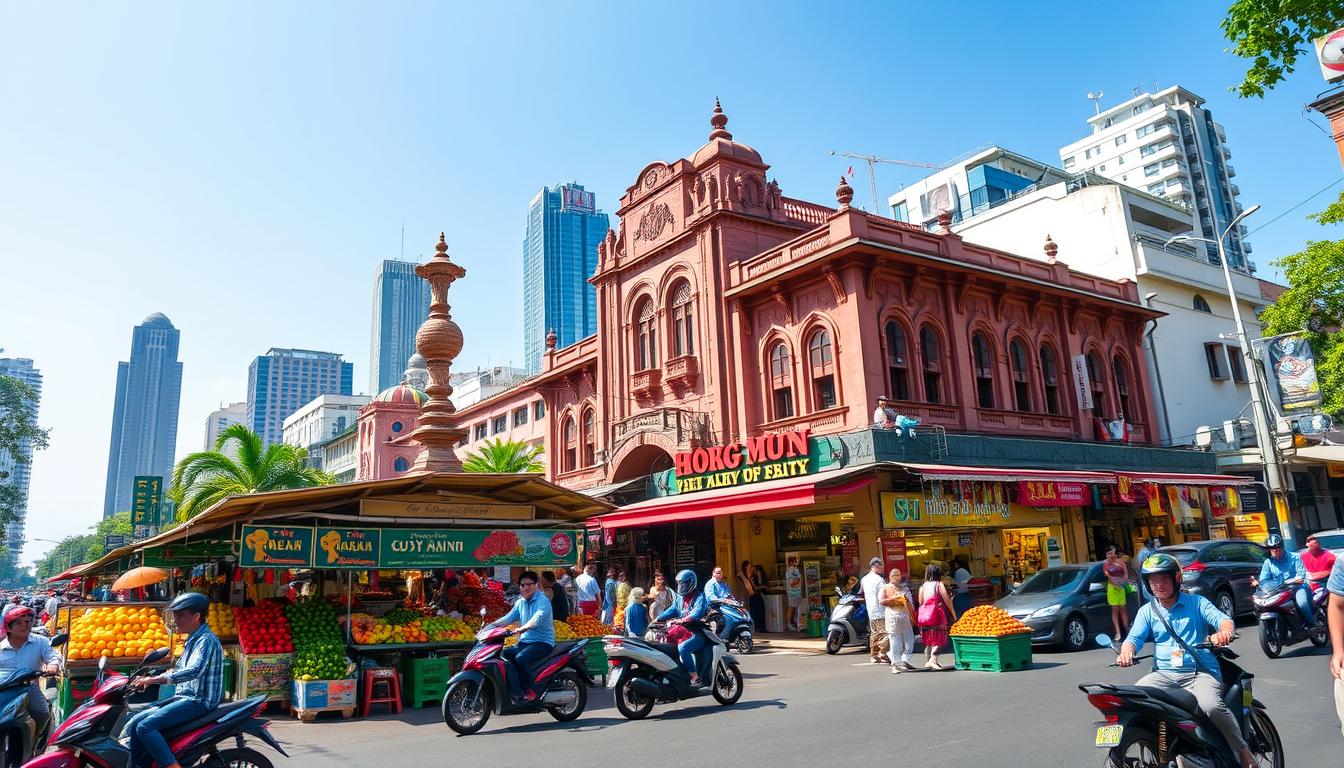
No responses yet